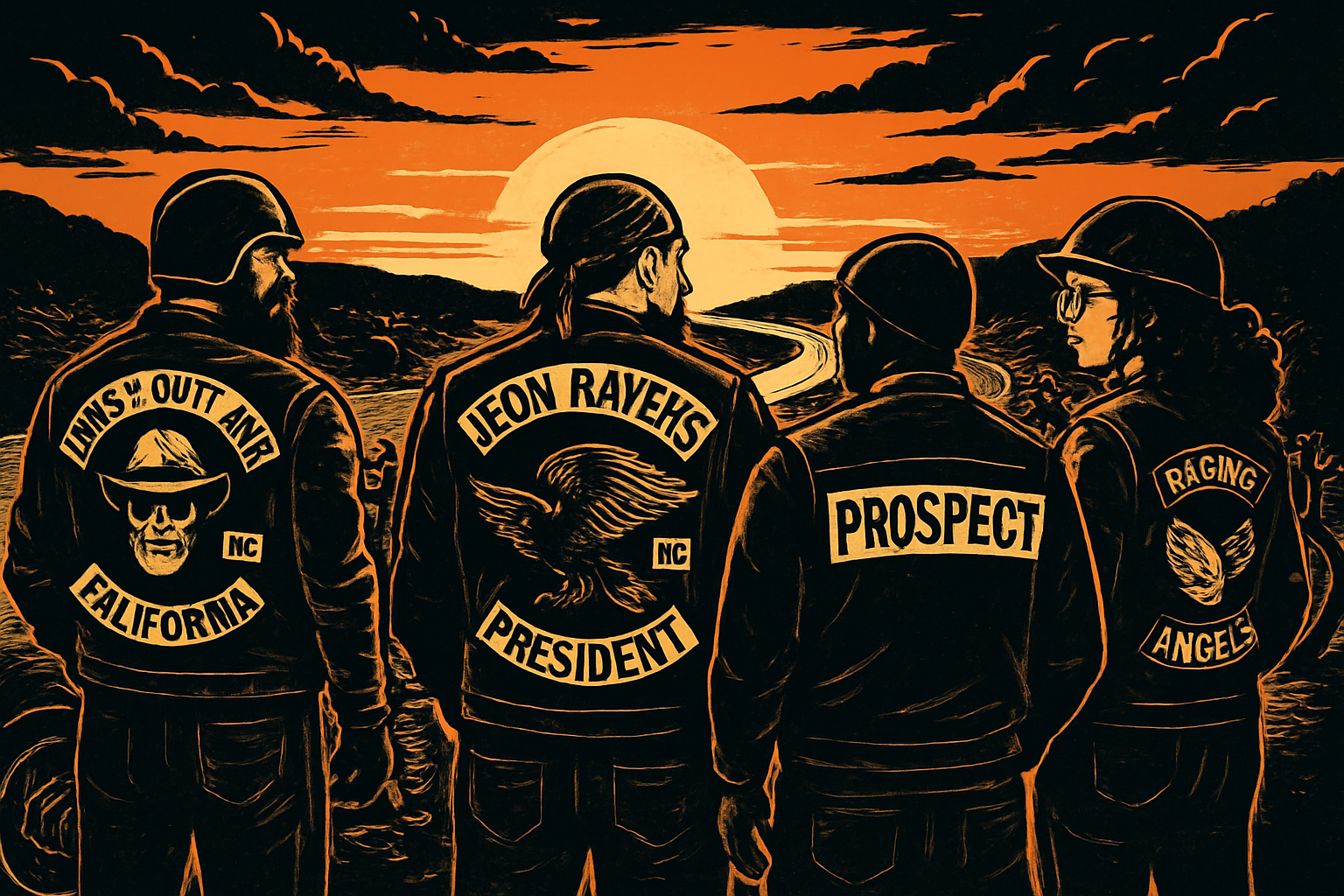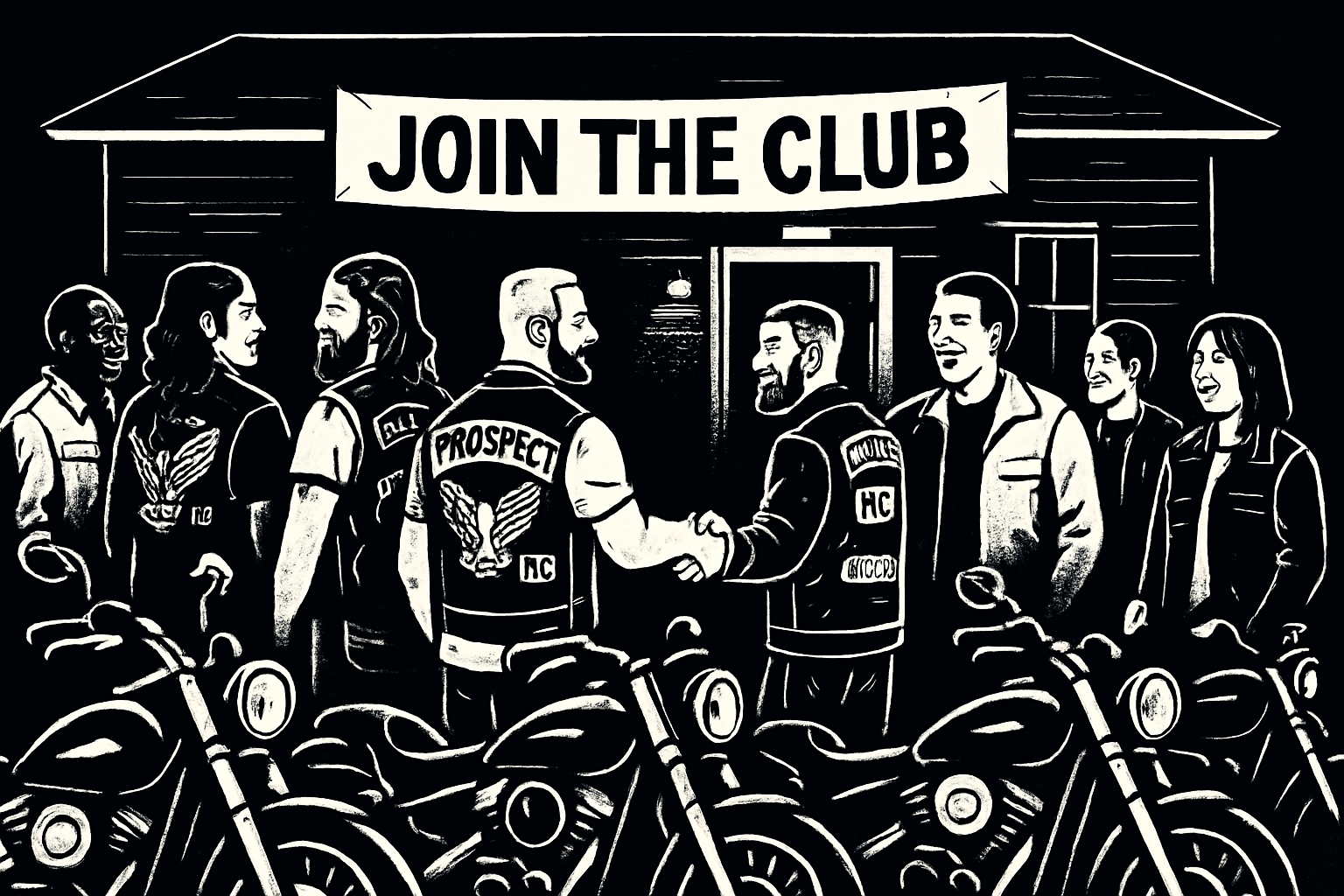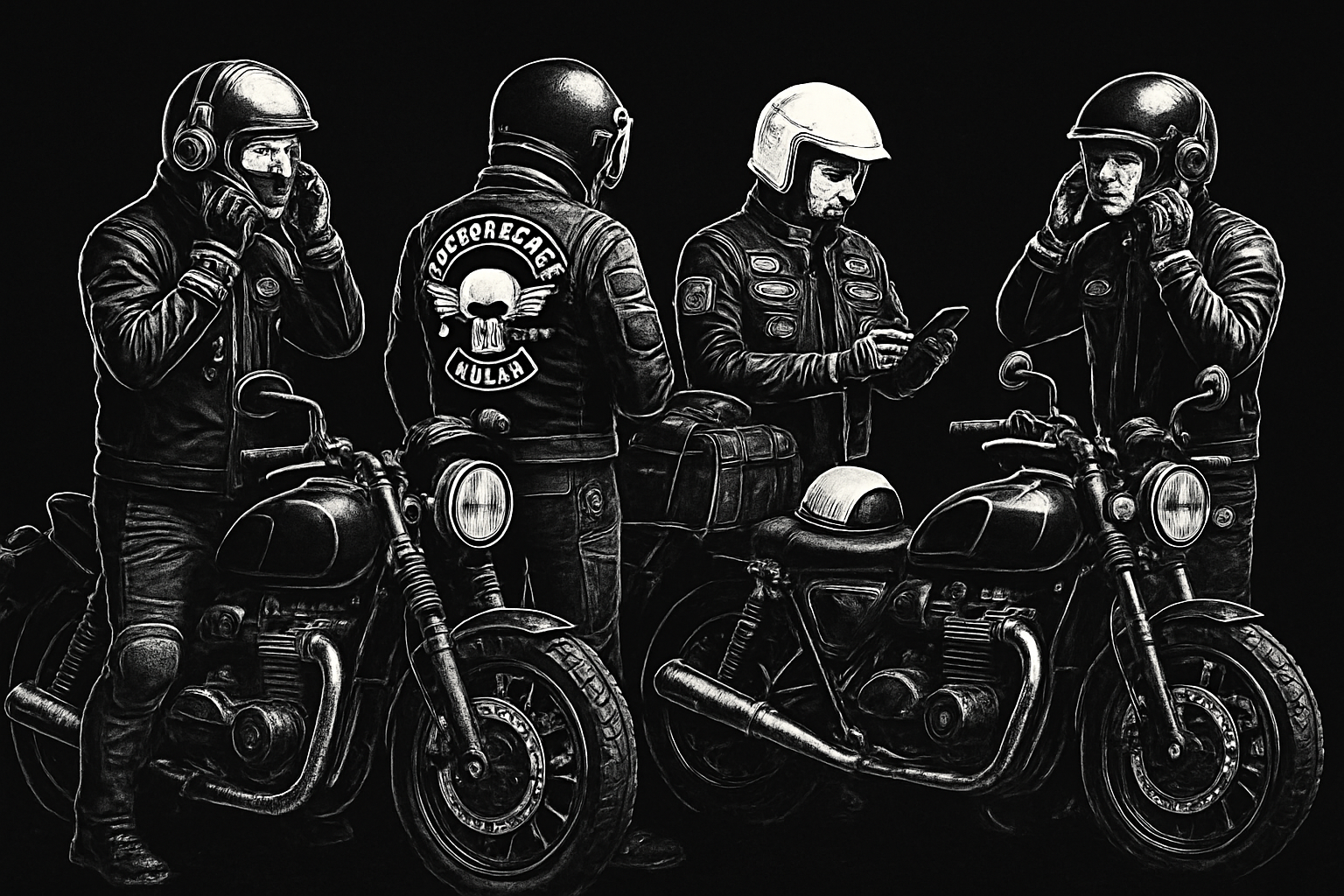Feel the rush of the open road and the bond of brotherhood that comes with joining a motorcycle riding club in 2025. Whether you’re a seasoned rider or just starting out, the world of clubs offers adventure, friendship, and a unique sense of belonging.
This comprehensive guide unlocks everything you need to know about motorcycle riding club culture. Discover the types, traditions, and structures that define clubs, plus step-by-step advice for joining, mastering etiquette, and choosing the right gear.
Ready to find your perfect club and ride with confidence? Let’s get started.
Understanding Motorcycle Riding Clubs: Types, Traditions, and Structures
Ever wondered what sets one motorcycle riding club apart from another? The world of riding clubs is rich with history, hierarchy, and unique traditions. Whether you’re drawn by the spirit of adventure or the bond of brotherhood, understanding these structures helps you find your place on the open road.

The Difference Between Motorcycle Clubs (MCs) and Riding Clubs (RCs)
Not all clubs are created equal. The most common types are Motorcycle Clubs (MCs) and Riding Clubs (RCs). An MC is typically more formal, with a defined hierarchy, strict rules, and deep-rooted traditions. An RC, on the other hand, is usually more relaxed, focusing on the joy of riding without the rigid structure.
Here’s a quick comparison:
| Feature | MCs | RCs |
|---|---|---|
| Structure | Formal hierarchy, bylaws | Informal, flexible roles |
| Membership | Invitation, prospecting, voting | Open, less formal process |
| Patches/Colors | Multi-piece patches, strict rules | Single patch, less strict |
| Culture | Brotherhood, loyalty, tradition | Social, riding enjoyment |
| Legal Status | Outlaw/non-outlaw, public perception | Mainstream, legal |
You might hear about "1% clubs." This term comes from the American Motorcyclist Association’s claim that 99% of riders are law-abiding, leaving 1% as “outlaws.” Not all motorcycle riding club groups are outlaws—many, like the Leathernecks LMCI or Marine Riders, are fully legal and respected.
Club hierarchies can be intricate. Common officer roles include president, vice president, secretary, treasurer, and sergeant at arms. There are also nomads—members not tied to one chapter but representing the club wherever they go.
Patch systems are a huge part of tradition. A prospect starts with a partial patch and must earn the full set through loyalty and dedication. Support clubs often wear associated patches, showing allegiance to a parent club. The symbolism of patches and colors (motorcycling) can’t be overstated—they represent identity, territory, and achievement within a motorcycle riding club.
For scale, estimates suggest there are over 300 MCs in the UK and thousands across the US, with tens of thousands of active members. Clubs like Hells Angels have become household names, but most motorcycle riding club members ride simply for camaraderie and adventure.
Club Values and Motives
At the heart of every motorcycle riding club are shared values. Brotherhood and loyalty are non-negotiable. Members look out for each other on and off the road. The passion for riding binds everyone together, regardless of background.
Many clubs are deeply involved in community service. Charity rides, such as the Paul Ehline Memorial Ride, are common. These events raise funds for veterans, families in need, or local causes. Military and veteran clubs add another layer of purpose, connecting those who have served.
Social life is a big draw, too. Group rides, club events, and rallies give members a sense of belonging. It’s about forging lifelong friendships and sharing unforgettable experiences.
Key motives for joining a motorcycle riding club include:
- The thrill of group rides and exploring new routes
- Building a sense of identity and pride
- Supporting charitable causes
- Enjoying a structured, respectful community
Ultimately, a motorcycle riding club is more than just a group—it’s a family. If you value connection, adventure, and giving back, there’s a club out there that matches your spirit.
How to Join a Motorcycle Riding Club: Step-by-Step Process
Joining a motorcycle riding club in 2025 can feel both exciting and overwhelming. With so many clubs and traditions, knowing where to start is key. This process isn’t just about riding—it’s about finding your tribe and building lasting connections. Here’s how you can confidently navigate the steps to become a valued member of a motorcycle riding club.

Research and Choose the Right Club
Before you join any motorcycle riding club, it’s important to do your homework. Start by searching for clubs in your area through online directories, local bike shops, or word of mouth. Many clubs host open rides or public events—these are great opportunities to experience different club atmospheres firsthand.
Think about what you want from your motorcycle riding club experience. Some clubs are brand-specific, while others focus on riding style, such as touring, adventure, or sport. You’ll also find open clubs that welcome all riders, as well as exclusive groups with stricter entry criteria.
Key steps to follow:
- Identify local clubs: Use online resources and visit local motorcycle shops.
- Assess club requirements: Check if they require a specific type of motorcycle, certain riding experience, or even a background check.
- Attend open events: Go to public rides or meetings as a guest to gauge the vibe.
- Evaluate club culture: Talk to members and observe how they interact.
- Use social media and websites: Many clubs share their values, events, and expectations online.
For a taste of upcoming rides and public gatherings, browse the Motorcycle club events and rides page to see what’s happening near you.
Remember, finding the right motorcycle riding club is like choosing a second family. Take your time, ask questions, and trust your instincts.
The Prospecting Period
Once you’ve found a motorcycle riding club that feels right, the next step is prospecting. Becoming a prospect means you’re in a trial phase—proving your commitment and learning the ropes before full membership.
During this period, you’ll be expected to:
- Attend regular meetings (often called “church”) and club rides.
- Support club activities, such as charity events or maintenance days.
- Show respect to all members and follow established protocols.
- Learn club traditions, history, and the meaning behind patches.
The prospecting phase usually lasts several months, but the exact duration varies by club. It’s a time to build trust, demonstrate loyalty, and absorb the unique culture of your chosen motorcycle riding club.
Prospects often face challenges, from balancing personal commitments to adapting to club expectations. Some find the responsibilities intense, while others thrive on the sense of purpose and camaraderie. Not everyone progresses to full membership—common reasons include lack of participation, cultural mismatch, or failing to meet club standards.
Embrace this period as a learning experience. The journey through prospecting is where many riders discover what it truly means to belong to a motorcycle riding club.
Achieving Full Membership
Earning your place as a full member is a proud milestone in any motorcycle riding club. This step usually requires consistent participation, demonstrated loyalty, and endorsement from existing members.
Each club has its own initiation process, but most avoid anything secretive or illegal. Instead, you might participate in a ceremony celebrating your journey from prospect to member. The moment you receive your full patch is symbolic—it marks your acceptance and the trust you’ve built within the motorcycle riding club.
As a full member, you’ll gain new rights and responsibilities:
- Voting on club matters and decisions.
- Wearing the full club patch and colors with pride.
- Mentoring new prospects and contributing to club growth.
- Representing the club at events and in the community.
Membership isn’t just a title; it’s an ongoing commitment to uphold the values and traditions of your motorcycle riding club. Be ready to participate, support your clubmates, and continue building the legacy for future riders.
Essential Motorcycle Club Etiquette and Protocols
Joining a motorcycle riding club is about more than just hitting the road with friends. Every club has its own set of etiquette and protocols that members are expected to follow. Understanding these traditions helps you earn respect and fit in seamlessly. Whether you’re new to the scene or looking to brush up, mastering these essentials is key to a positive club experience.

Dress Codes and Club Colors
Dress code is a cornerstone of motorcycle riding club culture. The most visible symbol is the club patch, which members proudly display on their vests or jackets. These patches typically include the club name, logo, and sometimes a "rocker" that denotes location or rank.
There’s a big difference between the attire of a motorcycle riding club and a more formal motorcycle club (MC). RCs often allow more flexibility, while MCs have strict dress codes and protocols. For example, MC members might wear a three-piece patch set (top rocker, club logo, bottom rocker) while RCs may use a single patch.
| Club Type | Typical Attire | Patch System |
|---|---|---|
| MC | Leather vest/jacket, full three-piece patch, specific colors | Full, partial, prospect |
| RC | Textile or leather, single patch or logo, less formal colors | Single patch, minimal hierarchy |
Respecting club insignia is crucial. Never touch or wear another club’s colors unless you’re a member. The "bottom rocker"—usually showing a state or region—signals territory and can carry big meaning in the motorcycle riding club world.
When attending club events, always follow the stated dress code. Avoid wearing patches or logos from clubs you’re not part of. These traditions help maintain order and show respect for the club’s legacy. Understanding these details makes your entry into a motorcycle riding club smoother and more welcoming.
Riding Etiquette and Group Rides
Riding in formation is one of the most thrilling parts of being in a motorcycle riding club. Clubs use staggered or side-by-side formations to keep rides safe and organized. The ride captain leads, and members are expected to maintain their position and spacing throughout the journey.
Hand signals are the language of the road, used to communicate stops, turns, or hazards. Learning these signals is a must for anyone joining a motorcycle riding club. Safety always comes first—follow the ride leader, keep headlights on, and check your gear before every ride.
Punctuality is another key value. Arriving late can disrupt the group and is seen as disrespectful. Always be prepared, fuel up beforehand, and listen for updates from marshals or the ride captain.
For a deeper dive into group riding formations and club safety rules, check out this comprehensive Motorcycle Club Riding Rules & Etiquette guide.
Mastering these habits shows you take your motorcycle riding club membership seriously and keeps everyone safe on the open road.
Club Meetings and Social Conduct
Club meetings, often called “church,” are where the heart of a motorcycle riding club beats strongest. Attendance is typically mandatory, and meetings follow a structured order led by club officers. When it’s time to speak, wait your turn and show respect—interrupting is frowned upon.
Supporting club events, from charity rides to social gatherings, is part of what makes a motorcycle riding club feel like family. Your participation strengthens bonds and helps maintain the club’s reputation.
Conflict is inevitable in any group, but clubs value loyalty and confidentiality. Disputes are handled internally, with members expected to keep club matters private. This loyalty helps preserve trust and unity within the motorcycle riding club.
By respecting these social protocols, you’ll quickly earn your place as a valued member and help your club thrive for years to come.
Motorcycle Riding Club Gear: Safety, Style, and Practicality
When you join a motorcycle riding club, your gear becomes more than just protection—it’s your badge of honor and a symbol of unity. The right setup keeps you safe, shows your club identity, and helps you handle any weather or road conditions that come your way.

Choosing the Right Motorcycle Gear
Every motorcycle riding club emphasizes the importance of safety and style. Your essential kit should always include:
- Helmet: Full-face or modular designs are most popular for protection.
- Jacket: Look for abrasion-resistant materials like leather or textile.
- Gloves: Padded, weather-proof gloves offer grip and comfort.
- Boots: Ankle-protecting, sturdy boots are a must.
- Riding Pants: Reinforced with armor or padding for extra safety.
Always check for CE ratings to ensure your gear meets safety standards. Laws in the UK and US may require specific helmet types or reflective elements, so double-check before hitting the road.
Weather can be unpredictable, so waterproof layers and thermal liners are smart additions. Many motorcycle riding club members personalize their gear with patches, but some clubs have rules about placement, especially for official insignia.
Looking to refine your kit? See this Essential motorcycle gear guide for detailed advice on gloves and other must-have items.
Keep your gear in top shape by cleaning it regularly and inspecting for wear. Many club riders recommend investing in high-quality pieces for longevity and comfort.
Accessorizing for Group Rides
Group rides are the heartbeat of any motorcycle riding club, and the right accessories keep you connected and prepared.
- Communication Devices: Intercoms and radios help you stay in touch with fellow riders.
- Luggage and Storage: Saddlebags, tank bags, or tail packs carry your essentials securely.
- Security Products: Locks and alarms deter theft when you’re parked at events.
- Navigation Tools: GPS units or phone mounts make route planning a breeze.
- Visibility Aids: Reflective vests and LED lights boost your presence, especially in low-light rides.
Choose accessories that suit your club’s riding style and trip length. Practicality is key, but don’t forget to check if your motorcycle riding club has guidelines on visible tech or extra gear.
Well-chosen accessories not only enhance your group riding experience but also show you’re a thoughtful, reliable club member.
Finding the Best Motorcycle Riding Club for You in 2025
Finding the right motorcycle riding club can feel like searching for your tribe. With so many options out there, it’s important to match your unique style, values, and goals to a club that feels like home. Here’s how to zero in on the perfect fit for your next adventure.
Identifying Your Riding Style and Goals
Before you join any motorcycle riding club, ask yourself what you want from the experience. Are you all about adrenaline and speed, or do you crave long-distance touring and scenic routes? Maybe vintage bikes or classic British machines are your passion, or perhaps you’re looking for a club that welcomes riders of all genders.
Popular club types include:
- Adventure clubs: Focused on exploration and off-road journeys.
- Touring clubs: Prefer long, scenic rides and group travel.
- Vintage or brand-specific clubs: Centered around classic bikes or certain manufacturers.
- Women-only or inclusive clubs: Designed for diversity and support.
If you’re curious about the broader scene, The British motorbiker community is a great place to explore different club cultures and see what resonates. The key is to find a motorcycle riding club that aligns with your lifestyle and makes every ride feel meaningful.
Evaluating Club Reputation and Community Impact
Once you’ve narrowed down your choices, it’s time to dig deeper into each motorcycle riding club’s reputation. Research their history, community involvement, and leadership. Look for clubs that support charity rides, host public events, and maintain a positive presence.
Tips for evaluation:
- Check reviews and testimonials from current and former members.
- Attend open events to see club dynamics in action.
- Assess club leadership and safety records for professionalism.
- Understand commitments: rules, dues, and event participation.
Transparency and a welcoming vibe are good signs. Clubs that are active in their communities often offer a stronger sense of belonging and purpose. Make sure the motorcycle riding club you choose has values and practices that match your own.
Avoiding Common Pitfalls
Not every motorcycle riding club is right for everyone. Watch out for red flags such as extreme exclusivity, poor communication, or any hint of illegal activity. Always review club rules thoroughly and understand the legal implications of your affiliation.
Common pitfalls to avoid:
- Ignoring your boundaries: Never compromise on safety or comfort.
- Overlooking leadership quality: Poor organization can lead to frustration.
- Missing warning signs: If something feels off, trust your instincts.
Learning from past controversies in club history can also help you steer clear of trouble. Choosing the right motorcycle riding club means balancing excitement with responsibility, so you can enjoy the ride and the camaraderie for years to come.
The Evolving Landscape of Motorcycle Riding Clubs in 2025
The world of the motorcycle riding club is shifting gears in 2025. Today’s clubs are more diverse, tech-driven, and community-focused than ever before. Whether you’re a seasoned rider or just considering your first club, understanding these changes can help you find your place on the road.
Trends and Innovations in Club Culture
Motorcycle riding club culture is experiencing a transformation. Clubs are becoming more inclusive, welcoming riders of all backgrounds, genders, and ages. This shift is driven by a younger generation seeking community and adventure, as well as more women joining the ranks.
Technology is also playing a huge part. Many clubs now organize rides and communicate using apps, GPS, and private online groups. Digital tools make it easier for members to stay connected and plan events. Sustainability is gaining traction, with some clubs embracing electric bikes and eco-friendly gear.
Demographics are evolving too. Recent Motorcycle Owner Statistics 2024 show a steady increase in younger and more diverse riders joining clubs. Changing laws and public perceptions have led clubs to focus on positive community involvement and safety. The modern motorcycle riding club is adapting to meet new expectations, making membership more accessible and appealing than ever.
The Role of Events and Charity Rides
Events and charity rides remain at the heart of every motorcycle riding club. Annual gatherings, like memorial rides or large-scale rallies, bring members together from across regions. These events are more than just social occasions—they’re opportunities to raise funds for meaningful causes and support local communities.
Clubs often collaborate to organize larger charity runs, amplifying their impact. Group rides are meticulously planned to ensure safety and maximize participation. The social aspect of these gatherings builds lasting friendships and reinforces the club’s sense of purpose.
Community service is a core value, with many clubs dedicating significant time and effort to fundraising projects. The impact of these events extends beyond club members, strengthening ties with neighborhoods and creating a positive image for every motorcycle riding club involved.
Navigating Legal and Safety Challenges
The legal landscape for motorcycle riding club activities is constantly changing. New regulations regarding group rides, event permits, and insurance requirements have become more common. Clubs must stay informed to avoid costly mistakes and ensure every ride is above board.
Insurance is now a top priority, with many clubs requiring proof of coverage for all members. Liability concerns are taken seriously, especially during public events. Working with law enforcement and local agencies helps clubs maintain a good reputation and smooth event planning.
Advocacy is growing, too. Many clubs are active in promoting rider rights and safety, lobbying for fair laws and better road conditions. Navigating these challenges is a vital part of running a successful and responsible motorcycle riding club today.
Future Outlook for Motorcycle Riding Clubs
Looking ahead, the motorcycle riding club community is poised for continued growth and innovation. Clubs are expected to become even more diverse, tech-savvy, and environmentally conscious. Younger riders and families are likely to play a bigger role, bringing fresh energy and ideas.
Challenges remain, such as adapting to stricter laws and maintaining strong leadership. However, the enduring appeal of camaraderie, shared adventures, and giving back to the community will keep clubs thriving.
If you’re considering joining a motorcycle riding club in 2025, now is the perfect time. Embrace the changes, seek out clubs that align with your values, and enjoy the ride as these organizations continue to evolve and inspire.
